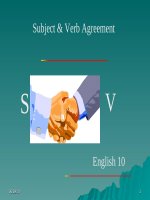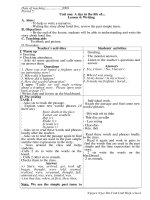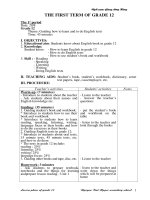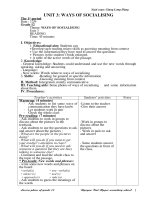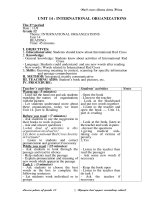Giáo án Anh 10 CB Unit 10, 11,12(chuẩn)
Bạn đang xem bản rút gọn của tài liệu. Xem và tải ngay bản đầy đủ của tài liệu tại đây (196.28 KB, 44 trang )
Ngêi so¹n: Giang L¬ng Hïng
Unit 10: Conservation
The 60
th
period
Date : 07/01
Grade 10
Theme: Conservation
Unit 10
Reading
Time: 45 minutes
I. Objectives:
1. Educational aim: Students will be able to:
- understand that forest and the earth give us a lot of valuable
things
- get information about destroying the earth, forest and animal
2. Knowledge:
- General knowledge: By the end of the lesson:
- students can enlarge their knowledge aout the earth, forest
- students will know how important is the earth in our lives and
do something to save the earth
- New words: words related to forest and animal
3. Skill: Improve reading comprehension through Matching and answering
questions
II. Method: Intergrated, mainly communicative
III. Teaching aids: Textbook, hand-outs
IV. Procedures:
Teacher’s activities Students’ activities Notes
Warm-up: (3 minutes)
- Ask students some questions
1. What is the meaning of the word
“conservation”?
2. Why do you have to protect forests
and animals?
3. How do you protect your earth?
- Ask students to work in pairs and give
their answers
- Give comments
- Answer the questions
in pairs:
1. Consevation is the
protection of natural
things such as plants and
animals.
2. Because forests give
us a lot of valuable
things.
3. We shouldn’t pollute
Lesson plans of grade 10 Nguyen Trai Upper secondary
school
1
Ngêi so¹n: Giang L ¬ng Hïng
Pre-reading: (5 minutes)
- Ask students some questions:
1. Have you ever visited a zoo or a
forest?
2. What animals are you interested in?
3. Do we need to protect animals and
forests?
- Say: “Ok, we have to protect animals
and forests because forests give us many
valuable things. Today, we study Unit 10
to know how important are forests and
animals in our lives”
While-reading: (26 minutes)
Task 1
- Ask students to read all words in A and
definition in B then read the passage to
find the words which appear in the
passage
- Ask students to match the words with a
suitable definition in B
- Let students work in pairs
- Walk round the class and give
comments when students need help
- Call on some students to explain their
answers in front of the class
- Give correct answers
1.c – 2.a – 3.d – 4.b
Task 2
- Ask students to read the statements
carefully before doing the task
- Ask students to scan the passage to get
specific information and encourage them
to guess whether those statements are T
or F
- Let students work in pairs
- Go around the class and provide help
when necessary
- Check the answer in front of the class
the air, cut plants…
- Answer the questions
1. Yes, I have.
2. I’m interested in tiger
3. Yes, we do.
- Read the passage and
do task 1
- Work in pairs
- Listen to their friends’
answers
- Copy down the
teacher’s correction
- Read the statements
- Work individually
- Work in pairs
- Correct the answers
Lesson plans of grade 10 Nguyen Trai Upper secondary
school
2
Ngêi so¹n: Giang L ¬ng Hïng
- Give correct answers:
1.F-2.I-3.T-4.T-5.F-6.T
Task 3
- Ask students to read all main ideas in
task 3
- Ask students to read the passage again
and choose the most suitable main idea
for each paragraph
- Ask students to work in groups
- Go around and provide help if needed
- Call on some students to give their
answers
- Give correct answers
Paragraph A:
Main idea: Forests give us a lot of
valuable things
Paragraph B:
Main idea: We can not live without water
Paragraph C:
Main idea: Lets do something to save the
earth
Post-reading: (10 minutes)
- Ask students to read the passage again
and then answer the questions
- Tell students to find and underline the
information that support the answers
- Ask students to work in pairs
- Call on some students to give their
answers
- Give correct answers:
1. The loss of much forest is destroying
the earth.
2. Man and most animals need a constant
supply of water to live. Farmers need
water for the crops
3. We should stop polluting rivers and
seas and stop the disappearance of plants
and animals.
- Read the main ideas
- Read the passage again
- Work in groups
- Correct answers
- Read the passage again
- Work in pairs
- Correct answers
- Listen to the teacher
and write down
Lesson plans of grade 10 Nguyen Trai Upper secondary
school
3
Ngêi so¹n: Giang L ¬ng Hïng
Homework: (1 minutes)
- Ask students to discuss the question:
What should we do for the future of“
planet?”
The 61
st
period
Date : 08/01
Grade 10
Theme: Conservation
Unit 10
Speaking
Time: 45 minutes
I. Objectives:
1. Educational aim: Students should understand how to talk about the
protection of many valuable animals by
reconstructing the animals’ natural environment
2. Knowledge:
- General knowledge: By the end of the lesson, students will be able to talk
about plans to protect animals
- New words: Words related to animals
3. Skill: Fluency in speaking about the conservation of many natural animals
II. Method: Intergrated, mainly communicative
III. Teaching aids: textbook, hand-outs
IV. Procedures:
Teacher’s activities Students’ activities Notes
Lesson plans of grade 10 Nguyen Trai Upper secondary
school
4
Ngêi so¹n: Giang L ¬ng Hïng
Pre-speaking: (9 minutes)
- Give hand-outs and explain how to
do: below is a list of animals.
Classifiy them to the following
catergories
Farm
animals
Wild and zoo
animals
Pets
horse, elephant, monkey, sheep, pig,
tiger, lion, cat, fish, panda, tortoise
- Ask students to work in pairs
- Check the answers in front of the
class
- Give correct answers
Farm
animals
Wild and zoo
animals
Pets
Horse,
sheep,
pig, fish
Elephant,
monkey, tiger,
lion, panda,
tortoise
Cat,
fish
- Raise the question:
What animals are in danger?
- Say: “Ok, nowadays, many kinds
of valuable animals are in danger.
Such as: elephant, tiger… so how
people do to protect them. Now, we
will come to part B: Speaking and
find how people protect them”
While-speaking: (25 minutes)
Task 1
- Ask students to read the paragraph
first
- Ask students to work in pairs
- Go around the class and check
- Call on some students to read their
answers
- Give correct answers
1. It is used to provide as natural an
environment as possible for the
- Listen to the teacher
- Work in pairs and do the
task
- Copy down
- Answer the question
They are elephant, tiger,
lion, tortoise ect.
- Listen to the teacher
- Read the passage
- Work in pairs
- Correct answers
Lesson plans of grade 10 Nguyen Trai Upper secondary
school
5
Ngêi so¹n: Giang L ¬ng Hïng
animals.
2. The places where endangered
species can develop. Animals can
live in natural environment. They
are not the places where animals are
imprisoned.
- Ask some students to translate into
Vietnamese
- Give comments
Task 2
- Ask students to read all statements
then put a tick in the right box to
show their agreement or
disagreement
- Let students wok in pairs
- Go round the class and provide
help when needed
- Check the answer in front of the
class
- Give correct answers:
1. Yes- 2.No- 3.Yes- 4.Yes- 5.Yes
Task 3
- Ask students to read all
statements
- Ask students to work in pairs
- Go around the class and provide
help if necessary
- Call on some students to discuss
the advantages and disadvantages of
zoos of the new kind
- Encourage students to make some
dialogues
- Give comments and suggestions
Advantages:
+ the conditions the animals are in
+ the animals that people can visit
Disadvantages:
+ the money spent on
rescontructions of the animals
natural environment
- Read all the statements
- Work in pairs
- Copy down the answers
- Read all the statements
- Work in pairs
- Do discussing
Lesson plans of grade 10 Nguyen Trai Upper secondary
school
6
Ngêi so¹n: Giang L ¬ng Hïng
+ the dangers that the keeper may
have
Post-speaking: (10 minutes)
Task 4
- Ask students to make group
reports
- Go around and provide help when
needed
- Call on some students to present
their report in front of the class
- Give comments
Homework: (1 minutes)
- Ask students to write a short
paragraph about the animals’ natural
zoo
- Make group reports
- Work in pairs
- Listen to their friends’
reports
- Listen to the teacher and
writedown
The 62
nd
period
Date : 09/01
Grade 10
Theme: Conservation
Unit 10
listening
Time: 45 minutes
Lesson plans of grade 10 Nguyen Trai Upper secondary
school
7
Ngêi so¹n: Giang L ¬ng Hïng
I. Objectives:
1. Educational aim: Students can listen and understand some information
about a forest fire
2. Knowledge:
- General knowledge: By the end of the lesson, students can be able to:
- Listen and talk about some causes of a forest fire
- Know how to care for their great forests and save them from
fire
- Language: Words related to whales
3. Skill: Listening for gist and specific information
II. Method: Intergrated, mainly communicative
III. Teaching aids: textbook, board
IV. Procedures:
Teacher’s activities Students’ activities Notes
Pre-listening: (14 minutes)
- Raise the question:
What may cause a forest fire?
- Ask students to work in pairs
- Call some students to read their
answers
- Give comments
- Give suggested answer: Some
reasons may cause a forest fire
+ A campfire near a heap of leaves
may easily cause a forest fire
+ In late summer, forest may easily
catch fire
- Ask students to close their books
- Ask students to listen all the words
related to the paragraph and repeat
While-listening: (20 minutes)
Task 1
- Ask students to read all events
carefully before listening
- Encourage students to guess
- Ask students to do the task
individually first
- Play the tape and ask them to number
- Listen to the teacher and
answer the question
- Work in pairs
- Listen to the teacher
- Close the books and listen
to the tape
- Read carefully
- Work individually
- Listen to the tape and
Lesson plans of grade 10 Nguyen Trai Upper secondary
school
8
Ngêi so¹n: Giang L ¬ng Hïng
the events in the order they hear
- Has students compare their
answers with their friends
- Call on some students to give their
answers
- Give correct answers:
3, 2, 5, 1, 4
Task 2: True or False
- Ask students to guess if the
statements are T or F before
listening
- Ask students to listen and decide
whether those statements are T or F
- Ask students to work individually
- Call on some students to read
their answers
- Give comments and give correct
answers:
1.F - 2.F - 3.T - 4.T - 5.F
Task 3
- Ask students to read all sentences
- Ask students to work individually
- Ask students to listen and tick the
sentences they hear
- Has students compare their
answers with their friends
- Call on some students to read
their answers
- Give comments and correct
answers:
1.B 2.A 3.A– –
Post-listening: (10 minutes)
- Ask students to work in pairs to
discuss how a forest fire may start
and what every ought to remember
- Go around the class to provide
help if necessary
- Call on some students to present
their topics
- Give comments
number the events
- Work in pairs
- Listen to their friends’
answers
- Correct answers
- Try to guess
- Listen carefully
- Work individually
- Correct mistakes
- Read all sentences
- Work individually
- Compare their answer
with their friends
- Copy down
- Work in pairs
- Listen to their friends’
topics
- Listen to the teacher and
Lesson plans of grade 10 Nguyen Trai Upper secondary
school
9
Ngêi so¹n: Giang L ¬ng Hïng
Homework: (2 minutes)
- Ask students to write a short
paragraph about “What may cause a
forest fire?”
write down
The 63
rd
period
Date : 10/01
Grade 10
Theme: Conservation
Unit 10
Writing
Time: 45 minutes
I. Objectives:
1. Educational aim: Students can write a letter of invitation
2. Knowledge:
- General knowledge: By the end of the lesson, students will be able to write a
letter of invitation
- New words: Words related to invitaion verb-phrases
3. Skill: Writing a letter of invitation
II. Method: Intergrated, mainly communicative
III. Teaching aids: textbook
IV. Procedures:
Teacher’s activities Students’ activities Notes
Pre-writing: (10 minutes)
- Ask students some questions:
1. Have you written a letter of
invitation?
2. What are some expression do you
write in a letter of invitation?
- Ask students to work in pairs
- Call on some students to read their
answers
- Give suggested answers
* Would you like to go out this
evening?
* Why don’t you go to the cinema
with me?
* Let’s go to the cinema.
- Answer the questions
- Work in pairs
- Copy the answers
- Listen to the teacher
Lesson plans of grade 10 Nguyen Trai Upper secondary
school
10
Ngêi so¹n: Giang L ¬ng Hïng
- Say: “There are many expressions
those you can use to write a letter of
invitation. Today, we study part D.
Writing to study how to write a
letter of invitation”
While-writing: (20 minutes)
Task 1
- Tell students to read all sentences
quickly
- Explain some new structures:
+ How about + V-ing
+ Do you feel like + V-ing
+ Would you like + to infinitive
+ Are you free + to infinitive
+ Why don’t you + bare infinitive
+ Shall we + bare infinitive
+ Can you + bare infinitive
- Ask students to write out the
sentences by matching the first half
in A with the most suitable half in B
- Ask students to work in pairs
- Go around to provide help if
necessary
- Call on some students to read their
answers
- Correct and give suggested
answers:
1.e – 2.g – 3.a – 4.h – 5.i – 6.d –
7.e – 8.b
Task 2
- Ask students to read task 2
- Ask students to fill each blank in
these invitation letters with a
suitable expression
- Let students work in pairs
- Go around to provide help
- Ask students to give their answers
- Correct and give suggested
answers
1. would you like
- Read quickly
- Copy down
- Do matching
- Work in pairs
- Correct answers
- Read the task
- Work in pairs
- Listen to their friends’
answers
- Correct the answers
Lesson plans of grade 10 Nguyen Trai Upper secondary
school
11
Ngêi so¹n: Giang L ¬ng Hïng
2. Are you free/ do you like
3. Can you/ let’s
Post-writing: (14 minutes)
Task 3
- Ask students to read the cues
quickly
- Ask students to write a letter,
using the cues
- Go around to give help if
necessary
- Call on some students to read their
letters in front of the class
- Correct and give suggestion
Homework: (1 minutes)
- Ask students to rewrite a letter
- Read the cues
- Write letter individually
- Find out mistakes and
give comments
- Listen to the teacher and
write down
The 64
th
period
Date : 12/01
Grade 10
Theme: Conservation
Unit 10
Language focus
Time: 45 minutes
I. Objectives:
1. Educational aim: Students can pronounce 2 sounds /b/ and /p/ correctly
and understand how to use the passive voice
2. Knowledge:
- General knowledge: By the end of this lesson, students will be able to:
- pronounce the sounds /b/ - /p/ clearly and correctly
- transform the active voice sentences into the passive voice
sentences
- New words: words related to sounds /p/ - /b/ and the passive voice
3. Skill: - Pronounce the sounds: /p/ - /b/ correctly
- Grammar: passive voice
II. Method: Intergrated, mainly communicative
III. Teaching aids: Textbook, tape, cassette player, handout
IV. Procedures:
Lesson plans of grade 10 Nguyen Trai Upper secondary
school
12
Ngêi so¹n: Giang L ¬ng Hïng
Teacher’s activities Students’ activities Notes
Pronunciation: (10 minutes)
+ Listen and repeat
- Demonstrate the sounds /p/ - /b/ by
pronouncing them clearly and
slowly
- Write on the board some words
related to 2 sounds /p/ and /b/
/b/: bee, ban, bad, bright
/p/: pea, pan, power
- Ask students to read loudly
- Call some students to repeat the
sounds clearly
- Check and correct their
pronunciation
+ Practise these sentences
- Ask students to work in pairs and
practice the sentences
- Go around and help students
- Call on some students to read the
sentences loudly
Grammar: (34 minutes)
The passive voice
Be + P2
a. Simple present passive:
- Give examples:
I am not invited to parties very
often.
The floor is cleaned by my mother.
- Ask students to read all sentences
- Ask students to give form of
simple present passive
- Give correct form:
S + am/is/are + P2
- Ask students to make sentences
b. Present progressive passive:
- Give some examples
Many new roads are being built in
this city.
- Listen to the teacher
- Copy down
- Read in chorus
- Listen and repeat
- Work in pairs
- Practise the sentences
- Listen to the teacher and
write down
- Read all the sentences in
chorus
- Give the form
- Listen to the teacher and
take notes
Lesson plans of grade 10 Nguyen Trai Upper secondary
school
13
Ngêi so¹n: Giang L ¬ng Hïng
The earth is being threatened.
- Ask students to read all sentences
- Ask students to give form of
present progressive passive
- Give comments
- Give correct form:
S + am/is/are + being + P2
- Ask students to give some
examples
Exercise 1
- Ask students to do exercise 1
- Has students compare their
answers with a friend
- Check the answers in front of the
class
- Give suggested answers:
1. were reported
2. grown
3. be spoken
4. am not invited
5. are being built
Exercise 2
- Ask students to do exercise 2
- Go around and give help if
necessary
- Call one student to do exercise 2
- Check the answers in front of the
class
- Give correct answers:
1. came/ had started/ were
2. is standing/ is photographed
3. have/ told
4. was laid/ decided
5. are… planted
Exercise 3
- Ask students to do exercise 3
- Go around and help students
- Call on one some students to give
answers
- Read in chorus
- Give form
- Copy down
- Do the task
- Work in pairs
- Give answers
- Correct the answers
- Do individually
- Look at the board and find
out mistakes
- Correct answers
- Work in pairs
- Find out mistakes
- Correct mistakes
Lesson plans of grade 10 Nguyen Trai Upper secondary
school
14
Ngêi so¹n: Giang L ¬ng Hïng
- Correct mistakes
- Give correct answers:
1. was organized
2. arrived
3. were met
4. taken
5. were cleaned/ had been cleaned
6. were put/ had been put
7. was
8. prepared
9. made
10. were sewed
Homework: (3 minutes)
- Ask students to do exercise in
workbook
- Ask students to prepare Unit 11 at
home
- Copy down
- Listen to the teacher and
write in the notebooks
Unit 11: National parks
The 65
th
period
Date : 14/01
Grade 10
Theme: National parks
Unit 11
Lesson plans of grade 10 Nguyen Trai Upper secondary
school
15
Ngêi so¹n: Giang L ¬ng Hïng
Reading
Time: 45 minutes
I. Objectives:
1. Educational aim: Students should know about some kinds of forests and
the useful forests to our lives
2. Knowledge:
- General knowledge: By the end of the lesson, students can know information
of some national parks
- Language: Students read and talk about forests
- New words: words related to forests: trees, animals, mountains…
3. Skill: Reading for general or specific information
II. Method: Intergrated, mainly communicative
III. Teaching aids: Textbook, some photos of forests or national parks
IV. Procedures:
Teacher’s activities Students’ activities Notes
Warm-up: (3 minutes)
- Give the picture of forest and ask some
questions:
* What can you see in the picture?
* What can forests provide us with?
* Can they help us protect the
environment?
Pre-reading: (7 minutes)
- Ask students some questions about
forests, parks…
* Can you tell about some national parks
in Viet Nam?
* Have you ever visited some of them?
* Where is Cuc Phuong?
While-reading: (22 minutes)
- Let students open the books and
- Observe the picture
- We can see trees,
animals, mountains…
- They provide us with
tree, food, animals,
some products of trees…
- Yes, they keep the
environment clean
- Work in pairs and
answer the questions:
- They are Cuc Phuong,
Cat Tien, Cat Ba, U
Minh, Bach Ma…
- Yes, we have. We have
visited Cuc Phuong.
- It’s in Ninh Binh.
- Open the books and
give the located parks in
each country
Lesson plans of grade 10 Nguyen Trai Upper secondary
school
16
Ngêi so¹n: Giang L ¬ng Hïng
observe three pictures which are about
three national parks in Viet Nam, Kenya,
USA…
- Let students read three paragraphs
silently and find some main information
- Ask students to work in groups to
answer some questions about each
National Park
- Cuc Phuong:
1. How far is it from Ha Noi?
2. What is the area of Cuc Phuong?
3. What is the best time to visit?
- Ask students to continue asking about
other parks
Task 1
- Ask students to work in pairs to find
words that suits each of the definitions
best
- Listen and remark
Task 2
- Has students practise answering the
questions
- Go around to listen and help them if
necessary
Post-reading: (10 minutes)
- Let students discuss in groups: Which
- Practise reading
- Work in groups and
answer the questions
1. It’s about 160 km
2. It’s over 200 square
kilometres.
3. It’s from Otober to
April
- Work in pairs
1. Establish: to start an
organization
2. Contain: to have
something inside
3. Species: a group/
groups of animals or
plants
4. Survival: a state of
continuing to live…
- Work in pairs and then
each pair asks and
answers the questions
+ What is the area of the
rainforest in Cuc
Phuong?
- It’s 200 square km
+ Why would November
be a suitable time to visit
this park?
- Because the weather is
dry.
- Work in groups
G1: I’d like to visit Cuc
Phuong because I want
Lesson plans of grade 10 Nguyen Trai Upper secondary
school
17
